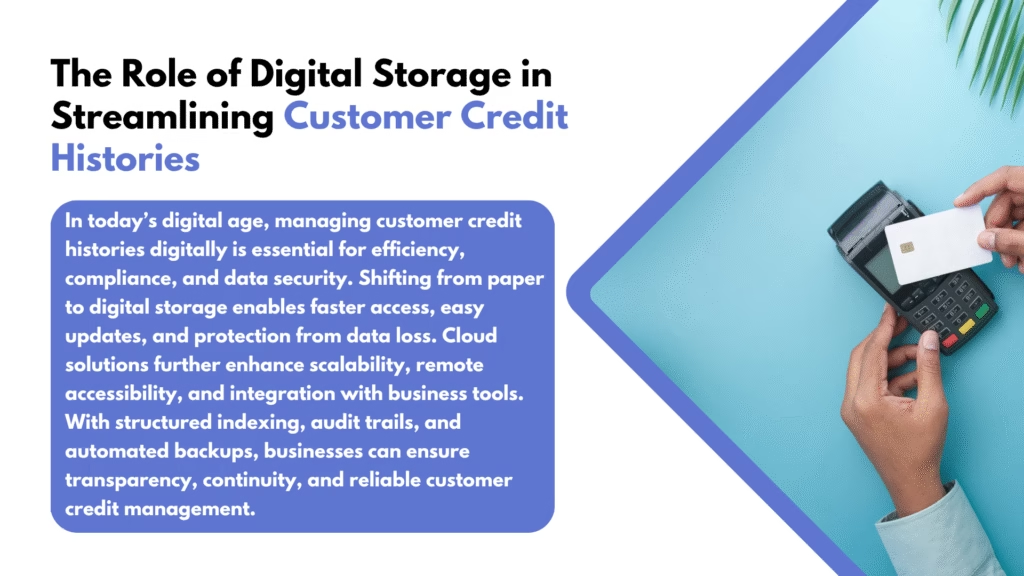Key Takeaways
- Cloud storage offers scalability, security, and remote access.
- Digital systems reduce retrieval time and human error.
- Structured data improves accuracy and accessibility.
- Version control and audit trails ensure transparency.
- Digital storage cuts physical storage costs and delays.
In today’s data-driven world, businesses especially in finance, banking, and retail, are collecting more customer information than ever. As customer bases grow and financial activities expand, volumes of credit histories, transaction records, and identity details have risen dramatically.
As this data continues to increase, the risks and responsibilities associated with managing it also increase. Improperly stored or mismanaged customer credit histories can slow down operations while simultaneously putting businesses at risk for compliance issues, inefficiencies, and huge errors. Paper files and disorganized digital folders are no longer effective. Modern businesses demand faster, more secure methods of managing information.
To forge ahead, companies are adopting more structured digital solutions. These digital solutions not only enhance accessibility and the secure environment for sensitive data, but they also optimize daily operations. Nevertheless, digital storage is more than paperless; it is about having the proper tools and systems in place to ensure the credit histories remain accurate, secure, and fast retrievable.
The Struggles of Managing Customer Credit Histories in a Digital World
Customer credit histories play a vital role across industries from financial services and trade to telecommunications and retail. Yet many companies still rely on outdated, inconsistent processes to track and manage these records despite the digital revolution. As a result, they face serious operational, compliance, and reputational risks.
Old Systems – An Increasingly Present Risk
Many organizations still rely on scattered systems such as Excel files, email attachments, and local drives to manage customer credit records. These methods are prone to data loss, duplication, and unauthorized access.
Without a centralized, structured repository, credit analysts and other staff struggle to access complete and accurate customer histories. Delays in retrieving past payment records or loan agreements slow down lending decisions and dispute resolution.
Lack of Strategic Approach
Almost 60% of respondents cited operational inefficiencies that were directly linked to a lack of a systematic strategy in managing customer data, as reported in a survey on data governance in financial institutions. Most of the inefficiencies stem from inconsistent standards of inputting data, a lack of defined ownership of a record, and ad hoc document updates. Lack of structured processes also means that scalability is limited with the organizational growth and increasing volume of customer credit files.
Compliance and Legal Exposure
Usually, these credit histories will include sensitive financial data such as loan repayment patterns, credit limits, and defaults. When stored insecurely or without proper audit trails, they can expose the organization to data protection violations.
Inappropriate treatment can lead to very severe consequences, from fines imposed by regulators to a loss of customer trust. Even more important is that the lack of transparency or traceability in credit records complicates regulatory audits and damages the credibility of the company with external stakeholders.
Human Error and Data Duplication
Another major risk is that of human error. Very small accidental typographical errors, like in a credit limit or repayment date, can cause very significant problems. They usually come from non-automated, non-standardized data entry systems.
Storing documents across different locations some scanned as PDFs and others kept as hard copies, makes it almost impossible to track accurate versions. As a result, records become inconsistent, making it difficult to trace true credit behavior over time.
The Role of Digital Storage in Streamlining Customer Credit Histories
In today’s digital age, it has become highly essential for any business truly focusing on streamlining operations and staying competitive to manage customer credit histories. As customer bases grow and regulatory demand increases, investing in digital storage and organization systems for credit histories will ensure the all-important factor for the success of a business.
Digitizing Customer Data
Shifting from the traditional method of keeping data in files to keeping it digitally is no longer a luxury but a dire necessity. Most firms dealing with credit information tend to deal with huge volumes of documentation, including payment histories, credit limits, account statuses, and customer identification details. Whether kept as paper or in physical formats, back-end records get delayed in access, incurring additional storage costs, damage, or loss.
Cloud Solutions:
The most favored method for securely storing high volumes of customer data-from credit histories to client complaints the cloud. Unlike the local or physical storage systems, which are generally bound to physical servers, cloud services allow the organization to store and access its data remotely.
Cloud solutions that offer the following advantages:
- Scalability: Cloud platforms can scale with your business, so when customer numbers grow, you may simply increase your storage space. Whether a handful of customer credit histories or millions of them are involved, cloud storage can be scaled up.
- Ease of Accessibility: It offers a way to view customer credit history documents from any point in the world, as long as an employee is connected to the internet. This is extremely supportive for businesses with members working from multiple locations or remote teams.
Data Structuring and Indexing
This is a great advantage of having the data stored digitally. The information, in contrast to traditional files, may be tagged with metadata, indexed by customer IDs, dates, or account types for swift access and retrieval. Thus, this systematic method ensures credit histories are not just stored but are usable for decision-making, reporting, or compliance checks.
Version Control and Audit Trails
In financial services, it is very important to keep track of the history of modifications made to a document. Digital systems can automatically create version histories and maintain detailed audit trails for all files, reflecting who, when, and in what manner accessed, altered, or evaluated the credit history of a customer. Such a feature enhances transparency while acting as a support to the internal audit and complying with the data governance standards.
Backup and Disaster Recovery
Customer credit histories are sensitive, if not entirely irreplaceable. Digital systems, more so cloud services, with the automation of backup functions, ensure that the customer’s credit history is not permanently destroyed through system failure, human error, or security attack. In cases of loss of data, the firms can easily recover previous versions or even entire datasets, maintaining continuity while fending off reputational damage with their customers.
My Struggle with Storing Customer Credit Histories Digitally
Some years ago, I was handling customer credit histories for a finance house. The heavy reliance on paper and old digital storage systems dictated our work. The cabinets housed hundreds of files worth of paperwork, and crucial documents were scattered in various places; a real bane to our operations.
The real trouble began whenever I had to retrieve a credit history. Important customer information was often missing or filed in the wrong place, causing delays and frustrating clients. I remember one urgent request for a credit report that was due in just a few hours. I spent almost an entire day searching through files and folders. It was exhausting, and the disorganized, decentralized system only made things worse.
Keeping documents updated was another issue. As the business expanded, our paper-based storage could not cope, and there was no effective way of editing or updating the records of customers. The whole system, therefore, just felt out of place in consideration of the speed and accuracy required in modern finance.
The Turnaround
After going through some challenges, I recognized something had to change. Continuing with physical documents and inefficient digital storage was simply impossible. Adapting a much-desired digital storage solution was the only solution visible.
I chose a cloud-based storage option. The first step in the transition was selecting a secure cloud service provider with ample storage capacity and strong encryption to protect customer data. During the move, we also focused on implementing a document management system (DMS) to simplify the categorization and retrieval of credit histories.
The move to the cloud marked the first major step in solving our problems. With all our files safely stored online, I could edit PDF document free, and accessing any record became a matter of seconds. No more time lost searching through physical files or ensuring that misplaced documents were sent electronically. In addition, we initiated a more organized categorization of credit histories in very handy ways, minimizing retrieval time and, therefore, human error dramatically.
Moving Forward: Future Steps in Digital Transformation
While it was already a big advancement into digital, there are still opportunities for further enhancements and process streamlining. I plan to factor in even more technologically advanced features, such as machine learning for predictive analysis of customer data, to have great insights about credit behaviors. Automated notifications trigger document updates or reminders, which will make the workflow more efficient.
Bottom Line
In today’s world, a reliable credit history storage system is no longer a luxury but a necessity. Organizations must have one to stay compliant and competitive. Shifting from traditional paper-based systems to digital, cloud-based environments improves speed and reduces human error. It also strengthens data security.
Digital tools such as cloud storage, data indexing, version control, and automated backups ensure faster retrieval, lower risks, and greater transparency in managing credit histories. Investing in these solutions is essential, as they simplify operations and reduce compliance risks. This move also prepares businesses for a future where data plays an increasingly critical role.


